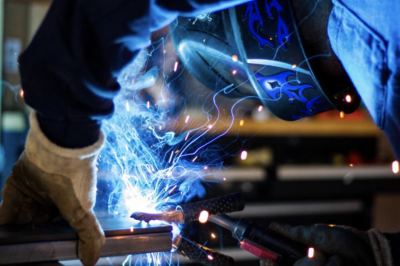
When you learn to weld, it can be easy to get overwhelmed by the amount of information and equipment available.
Every welding method has its strengths and weaknesses. Let’s go over the basic types of welders, as well as their primary uses so that you can find the right one for your project.
Types of Welders
The four basic types of welders are these;
- TIG Welding
TIG (short for Tungsten Inert Gas) welding uses an inert gas like argon or helium to protect the weld area from atmospheric contamination (like oxidation).
- Gas Welding
Gas welding uses fuel gasses or liquid fuels (like gasoline) and oxygen to weld or cut metals.
- Electron Beam Welding
Electron beam welding uses a beam of high-velocity electrons to join materials. As they collide with the surface, they impart energy and heat.
- Plasma Arc Welding
Plasma Arc welding is similar to TIG, but does not require allows the beam and gas envelope to be separated.
There is one honorable mention that shouldn’t be ignored: Stick welding (the most basic type of welding). You are sure to learn about it on your way to proficiency in any other class, and it can be useful for basic weld jobs.
Strengths and Weaknesses
TIG
TIG produces solid, very high-quality welds. However, the process is challenging to learn and even more challenging to master.
Gas
Gas welding is useful in unideal environments, such as windy or outdoor areas. The slow rate of heating and larger heat effected area means that these welds are not as strong or high quality, however.
Electron Beam
Electron beam welding is exceptionally accurate and can produce the highest quality welds. However, equipment and training are expensive and hard to come by.
Plasma Arc
Plasma arc welding is very accurate for tiny areas. However, it can require more concentration than some of the other methods.
Best Applications
TIG
TIG is best when a proper balance of high quality and ease is a priority. If a skilled TIG or MIG welder is available, they are likely your best option for aluminum welding. Overall, this is the best tool to add to your welding kit.
Gas
Utilize gas welding with thin materials and simple repairs, such as pipes. Another benefit is that base materials are only minimally diluted.
Electron Beam
Electron beam welding is the standard for jobs requiring extreme precision, like nuclear welds and spacecraft.
Plasma Arc
Plasma arc welding finds its best use in the aircraft manufacturing industry. The high rate of accuracy and extreme temperatures possible, as well as the ability to create deeper welds, provide a lot of benefits for this method.
Where to Start
If you’re studying to be a professional welder, your focus should be on where you’ll find the most work. You should also focus on general, transferrable skills that will benefit you as the field evolves.
Of the types of welding tools listed above, TIG has the most market penetration by far. These factors make it the most appealing option if you’re starting in the field. Other types of welders can come in handy when the situation calls for it, but you won’t go wrong focusing on TIG.
Don’t forget to bookmark our site to never miss our latest posts!


